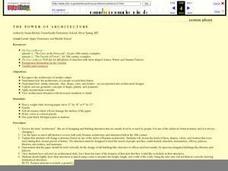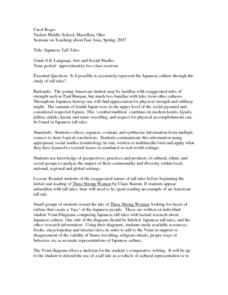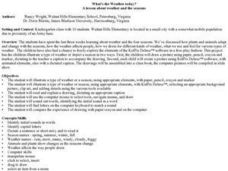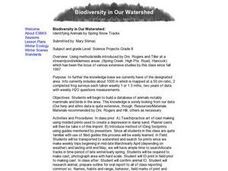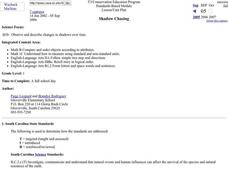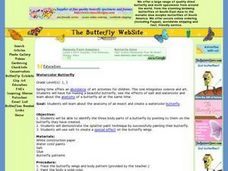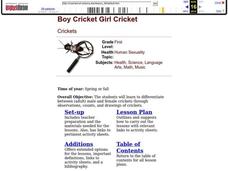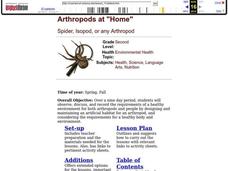Curated OER
Kokeshi Dolls
Students create Kokeshi Dolls using paints, dowel ends and glue. They research the traditions and history of Hina Matsuri, or girls' day in Japan.
Curated OER
Weatherman Phil
Third graders examine the life of a groundhog and their role in predicting weather. They write a postcard or a letter to Punxsutawney Phil on the Internet.
Curated OER
Food to Grow On
First graders observe, predict, and record food consumption and growth of insects through experimentation with caterpillar diets. They relate their findings to their own growth and diet.
Curated OER
Grooming Is A Good Thing
Students construct fly traps, collect house flies, and observe the flies grooming. They compare/contrast the fly's grooming techniques with their own. They develop a good grooming habits chart.
Curated OER
T H E P O W E R O F A R C H I T E C T U R E
Young scholars arecognize the architecture of another culture, how the architecture of a people records their history, explore artistic elements, explore and use geometric concepts of shape, pattern, and symmetry.
Curated OER
Trivia Books: Louisiana Purchase Bicentennial Celebration
Students detrmine the importance of point of view. They use a well-known fairy tale to explore how changing the point of view changes the whole story. They generate questions from the text they want answered during the unit and construct...
Curated OER
Exploring the Night Sky: Fall/Winter
Students explain how moon phases occur. They explain three ways that the night sky has been used through history. Students locate some of the constellations in the night sky. They discuss stories and myths surrounding stars.
Curated OER
Where Does the Green Go?
Students investigate why green leaves change colors in the fall. They press leaves and write a poem, create a chlorophyll leaf print, take a nature walk, and create a leaf shape poster.
Curated OER
To Every Thing There Is A Season...
Students use the artwork by Robert Harris to examine the four seasons. In groups, they identify the clothing worn in the artwork and create a dance which resembles the painting. They also practice reading a thermometer and identify...
Curated OER
Japanese Tall Tales
Students read the tale of 'Three Strong Women' looking for facets of culture that create a 'face' of the Japanese people. They create a Venn Diagram comparing Japanese tall tales with factual research about Japanese culture. One side...
Curated OER
What Do Trees Do for Dinner?
Students investigate how trees produce their own food. They examine chlorophyll cells with a microscope, analyze a cross section of a log, determine how old the tree was, simulate the distance of the roots, and create a play.
Curated OER
Plants
Third graders study the factors necessary for plant growth and how plants adapt to their environment. They examine ow different plants require different environments to thrive.
Curated OER
Weather And The Seasons
Students illustrate characteristics of the different seasons using digital and pen and paper drawings. They creat captions for their drawings and present them to the class. Students compare and contrast their pen and paper drawing...
Curated OER
Appreciation Cards
Students discuss jobs in which have impacted their lives directly. They create appreciation cards for a person who they believe needs appreciation. They give their cards to that person and share their reaction with the class.
Curated OER
Biodiversity in Our Watershed
Eighth graders create a database of animals and birds in the area in which they live. They use molded prints to make a cast of an imprint from a specific animal. They identify and research animals and prepare an outline for an oral...
Curated OER
Shadow Chasing
First graders observe and measure their shadows. They go outside at three hour increments during the course of a day. Each time students measure and record the length of their shadows. Students read books about shadows and discuss why...
Curated OER
Italy: Festa del Grillo
Students examine the traditions of the Festa del Grillo in Italy and its relationship to the culture of Italy. After being shown examples, they create their own cricket out of materials found in the classroom. Using 3D, they decorate a...
Curated OER
Watercolor Butterfly
Students identify and analyze the anatomy of an insect and create a watercolor butterfly. They identify the three body parts of a butterfly by pointing to them on the butterfly they have created and demonstrate the splatter paint...
Curated OER
Arbor Day Across the United States
Learners perform research about hardiness zones used to guide planting. They read a hardiness zone color-key map and create their own color-key maps to show when different states celebrate Arbor Day.
Curated OER
Head, Shoulders, Knees & Toes
Students, through observation of crickets, recognize and use proper names for human and insect body parts. They compare and contrast parts of human and insect body parts.
Curated OER
Think Safe! Be Safe!
Students predict, observe, and explain how pillbugs, grasshoppers, stink bugs, and humans stay safe and protect themselves.
Curated OER
Boy Cricket Girl Cricket
First graders differentiate between (adult) male and female crickets through observations, counts, and drawings of crickets.
Curated OER
Arthropods at
Learners observe, discuss, and record the requirements of a healthy environment for both arthropods and people by designing and maintaining an artificial habitat for an arthropod.
Curated OER
Working with Willows
Students explore their sense of touch and discover why the sense of touch is important to us and to how we observe and identify our world.






